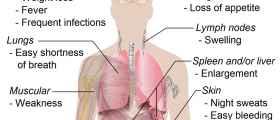
Anemia is characterized by decreased amount of hemoglobin in the blood or decreased number of red blood cells. This can be acute or chronic condition, depending on the duration. However, another possible categorization of anemias is based on the cause and there are anemias associated with blood loss, decreased production of red blood cells and some linked to increased destruction of these cells in the blood.
Conditions Linked with Anemia
When someone gets diagnosed with anemia it simply means that she or he is suffering from some disease or condition, since anemia is not a diagnosis in itself. Many infections, inflammations and even cancers have been known to have anemia as one of the symptoms.
Hypermenorrhea (abnormally heavy and prolonged menstrual periods), poor diet and iron deficiency are often connected with anemia. Patients with previous history of anemia or some blood transfusion, those suffering from coagulation disorders or thrombocytopenia may also experience anemia as well. Other conditions that might have anemia include: gastritis, hypothyroidism (underactive thyroid gland), gastric or duodenal ulcers, sickle cell disease and chronic illnesses like rheumatic disease or even cancer.
Types of Anemia
There are several types of anemia, known as mycrocytic, macrocytic, normocytic and hemolytic.
Microcytic hypochromic anemia can be provoked by lack of iron in the body, lead poisoning, sideroblast or thalassemia. Deficiency of vitamin B12 or folate, hypothyroidism and liver disease are possible causes of macrocytic anemia. Normocytic anemia may be primary condition of the bone marrow or secondary, associated with another medical condition.
Primary anemias can further be divided into aplastic and myelophthisic anemias. Myelophthisic anemia is usually caused by accumulation of malignant cells, reactive cells or reactive cell products, which affects normal hematopoiesis (production of blood). Diseases such as malignancies of the bone marrow, cancers frequently known to metastasize to bone marrow, other metastatic tumors and granulomatous diseases like sarcoidosis or tuberculosis are all known to lead to myelophthisic anemia.
Hemolytic anemias are: aortic valve prosthesis, cold agglutinin disease, disseminated intravascular coagulation (DIC), hemolytic uremic syndrome, sickle cell anemia, paroxysmal cold hemoglobinuria (PCH) and thrombotic thrombocytopenic purpura (TTP).
Most people suffering from anemia usually have problems with some other condition and these anemias are known as secondary. There are numerous reasons that might provoke anemia and some of these conditions are: chronic inflammation, uremia, liver cirrhosis and under-activity of certain glands like thyroid, pituitary or adrenal gland.Anemia Prognosis and Complications
Patient’s age, diet, access to medical care, other medical problems the patient has and chronicity of anemia determine the prognosis for this condition. Chronic anemia may cause persistent hypoxia of the tissues and this is one of potential complications.
Some patients might not be ready to comply with follow-up and their treatment, which may also lead to certain problems. Children, elderly and immune-compromised patients are considered to be high risk groups for chronic anemia problems.

















Your thoughts on this
Loading...